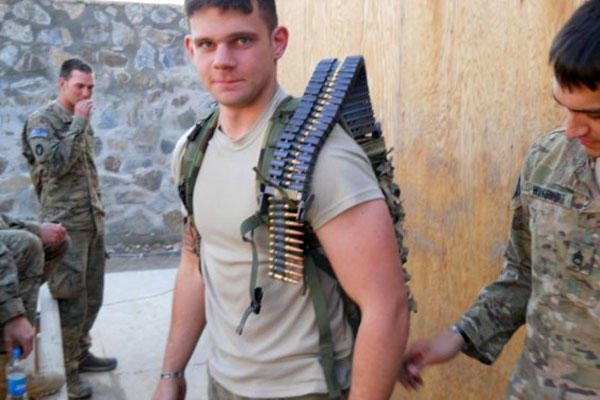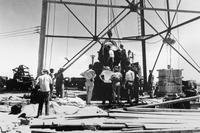NATICK, Mass. -- After he thumbed through the forward operational assessment report for the Large Capacity Ammunition Carriage System, or what has become known as the "Ironman," Dave Roy paused to make a football analogy.
A former member of the Natick Soldier Research, Development and Engineering Center Quick Reaction Cell, Roy said that NSRDEC had gotten the highly publicized system ready to hand off "to someone who can run this ball into the end zone for a touchdown, instead of leaving it on the 50-yard line."
To be sure, plenty of real estate remains between the Ironman and the goal line. What began as the brainchild of an Iowa National Guard unit in Afghanistan as a method for a single gunner to carry a large amount of ammunition for the Mk 48 7.62 mm machine gun, however, is much closer to becoming part of the Army inventory than it was at its birth.
"I'm very pleased that the forward operational assessment was conducted," said Roy, who was with the QRC at Ironman's outset but has since moved on to another position at Natick. "It is difficult to conduct these types of assessments in theater, regardless of the complexity of the system.
"To just get this report from (Army Test and Evaluation Command) is a huge accomplishment. This is just one step down that road."
The report included evaluations by 13 Soldiers deployed to Afghanistan -- a captain, two senior NCOs and 10 junior enlisted -- focused on the positive and negative aspects of the Ironman, named one of the Army's top inventions of 2010.
"I think that the target audience that they looked at from their sample population was the right audience," Roy said. "It looked at enlisted Soldiers, primarily, with one captain, which I think is the right balance."
A retired Army officer, Roy said he valued the perspectives of these Soldiers, whose experience in theater ranged from two to nine months and whose time in their units ranged from 10 months to more than four years. They liked some aspects of the Ironman and disliked others. They also offered comments and suggestions of ways to improve the fledgling system.
"These comments, positive and negative, allow us to improve the baseline design," Roy said. "The positive ones reinforce that the design meets broadly defined criteria. The negative comments, suggestions on how to modify the kit so that it better addresses capability gaps from the perspective of the Soldier, are invaluable."
To date, approximately 100 of the Ironman prototypes have been sent to Afghanistan through the Rapid Equipping Force. The system is now being used with the M240B machine gun.
"We have developed something that is repeatable," Roy said. "That is the goal of every scientist and engineer."
Roy recalled how Ironman had begun during a discussion between members of the 1st Battalion, 133rd Infantry Regiment, 2nd Brigade Combat Team, 34th Infantry Division, about how three-man, crew-served weapons teams struggled to stay together during engagements with the enemy while negotiating difficult terrain. Wouldn't it be nice, someone said, if they had a one-man weapon system like the one actor Jesse Venture had brandished in the movie "Predator"?
The Guardsmen built their own prototype using discarded ammo cans welded together and strapped to an old ALICE frame. They handed over the prototype to the QRC.
"If the Soldiers at point of impact have determined there is a capability gap, it is our responsibility in the (science and technology) community to see what we can do to answer that request for a potential material solution," Roy said. "We can't search for perfect. From the Soldier's perspective, good enough is million times better than what he or she has today."
With help from Natick experts in prototypes, load carriage, machining and fabrication, the QRC gave the Guardsmen an enhanced version of the Ironman, which held 500 rounds of ammunition and weighed 43 pounds.
"This is something that every Soldier is told: You can make a difference," Roy said. "You are an American Soldier. You can make a difference.
"Not every idea is applicable outside your squad. This idea is not one of them. This idea is not an idea that you say 'No' (to)."
Soldiers aren't the only ones curious about the system. Army Capt. J.R. Johnson, currently assigned to the QRC, said that the Navy recently made an unexpected inquiry about the Ironman for near-shore use.
"They were very interested in the Ironman," Johnson said. "We sent them one."
Johnson said the Ironman's future has yet to be determined.
"We're kind of, at this point, letting the operational need for it kind of drive it, which we are seeing in the special operations community," Johnson said. "Just to be able to have the capability available and to improve that capability, I think, is the key to going forward with this."
Roy was careful to point out that the Ironman was never intended to have universal application on the battlefield.
"This is simply a tool to use in specific situations," Roy said. "This is not a piece of kit that would be issued carte blanche to every infantry unit in the Army. This is not a panacea.
"Merely put this tool in the tool shed so when it's time to plow that piece of ground, they know where that tool is and they can go get it."
Roy called the Ironman a "force multiplier" that hasn't cost the Army a lot of money.
"We did this on a very small budget," said Roy, "and we're having a huge impact."



























